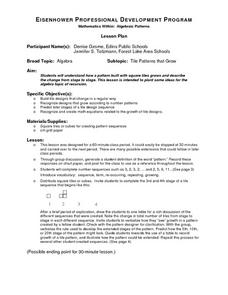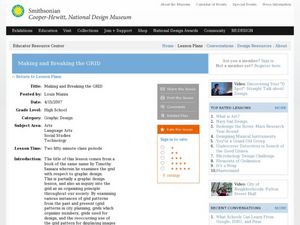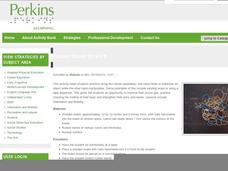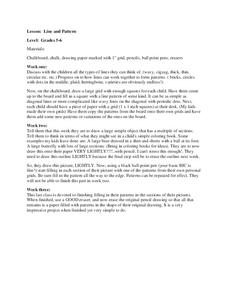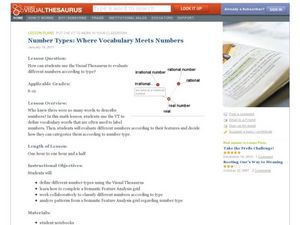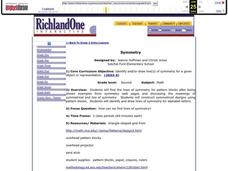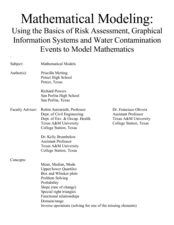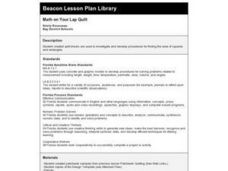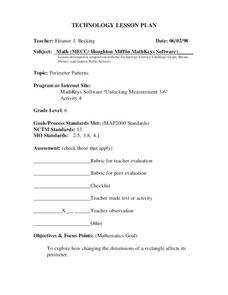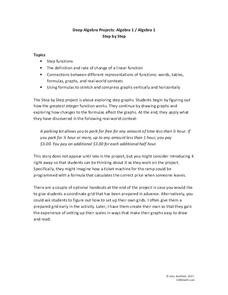Curated OER
Using Geometric Shapes To Make Patterns
Sixth graders explore the use of shapes to create geometric patterns. they start with a simple example of dividing shapes in half to create two new ones. This can be extended to creating intricate patterns.
Curated OER
Tile Patterns that Grow
Students explore how a pattern built with square tiles grows and describe the change from stage to stage. They predict later stages of a tile design sequence and create math equations related to the growth of tile designs.
Curated OER
Leaf Patterns
First graders explore the existence of patterns in everyday items. In this science and math integrated lesson, 1st graders match leaves with a name word card and organize them into four patterns. This lesson includes a reading of And the...
Curated OER
10 x 10 Paper Grid
In this math literacy paper, students find the solution to counting to ten in various patterns. They can practice counting horizontally or vertically.
Curated OER
Hundred Chart
In this math worksheet, students examine a chart which features the numbers from 1 to 100 in a grid. There are no directions for this chart which can be used in many ways for discovering number patterns, place value or multiples.
Curated OER
ROV Grid Search
Students perform activities to recreate the exploration of the sea bottom. They attach magnets to the bottom of the remote controlled car to see how many camouflaged objects it can pick up. As a class, students examine the results of...
Curated OER
Make Your Own Quilt
In this quilt patterns instructional activity, 2nd graders analyze the pattern in two rows of 12 shapes. Students continue the pattern in the empty grid to complete the quilt design.
Curated OER
Making and Breaking the Grid
Young scholars examine the grid in terms of a method of organization in our society as well as graphic design. In this "Making and Breaking the Grid" lesson, students design solutions to common problems and draw conclusions about...
Perkins School for the Blind
Rubber Band Stretch
If you don't teach blind or visually impaired students, this instructional activity may seem a bit strange. But, it helps them develop motor skills, orientation and movement skills, and listening skills, while building a better...
Curated OER
Line and Pattern
Students investigate lines and patterns. In this line and pattern lesson, students discuss types of lines and work on grids. They draw a picture very lightly before filling it in with the pattern they made in the grid.
Curated OER
Free Printables: Number Square
In this number square worksheet, students enter in the missing numbers in the number square. Teachers use the worksheet generator to select specific options when creating this worksheet.
Curated OER
Multiple Patterns
Second graders utilize a 1-100 grid to identify multiples of single digit numbers. They look for patterns and how they could be used to identify multiples to demonstrate the ability to use the multiplication facts and charts of single...
Curated OER
Number Types: Where Vocabulary Meets Numbers
Rational, irrational, real, natural. All these words can refer to numbers. Who knew? Learners use the Visual Thesaurus and a semantic feature analysis grid to examine the different attributes of numbers. Step-by-step instructions for...
Curated OER
Riding on a Pendulum
A comprehensive resource gets fourth grade physical scientists making observations about the period of a pendulum and then applying knowledge to a playground swing. Through seven different stations, they will record observations and...
Curated OER
Grade 3: What Can I Make with 30 Centimeters?
Third graders create polygons with perimeters of 30 centimeters, use the centimeter grid paper to determine the area of each shape, and organize the shapes to make generalizations from the patterns they see.
Curated OER
Symmetry
Second graders find the lines of symmetry in pattern blocks and alphabet letters. In this symmetry lesson, 2nd graders discuss what symmetry is, view examples of lines of symmetry and apply what they have learned by finding the line of...
Curated OER
Mathematical Modeling
Study various types of mathematical models in this math lesson. Learners calculate the slope to determine the risk in a situation described. They respond to a number of questions and analyze their statistical data. Then, they determine...
Curated OER
Math On Your Lap Quilt
Get creative juices flowing when you allow groups to figure out a procedure for how to find the area of squares and rectangles. They may use the individual patchwork blocks, or they may design one using the Design Template.
Curated OER
Place Values and Patterns, What is the Value?
First graders discover the significance of a number's place value by interactively engaging patterns and two-digit place values. For this mathematics lesson, 1st graders complete a 10 by 10 grid to create a number puzzle.
Pennsylvania Department of Education
Multiple Patterns
Students explore patterns that involve doubling numbers. For this multiple patterns lesson, students use objects to explore these patterns while recording them using a table. Students recognize even and odd number patterns while applying...
Curated OER
Number Squares
In this order of numbers worksheet, students write a number in each square of a 9 square grid. Students must write the numbers in order down and across. Only one number is provided in each square.
Curated OER
Perimeter Patterns
Sixth graders calculate perimeter of rectangles with different dimensions. In this perimeter lesson, 6th graders define length, width and perimeter. Students complete a perimeter activity using a web tool to change the...
5280 Math
Step by Step
One step at a time! A seemingly linear relationship becomes an entirely new type of function. Young scholars build their understanding of step functions by completing a three-stage activity that incorporates multiple representations of...
K12 Reader
Points on a Coordinate Grid
Introduce your class to the basics of coordinate planes. The reading passage included here describes ordered pairs and the different quadrants on a coordinate grid. Learners read the passage and respond to five related questions.

